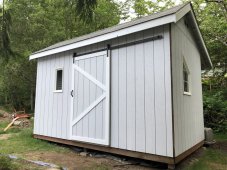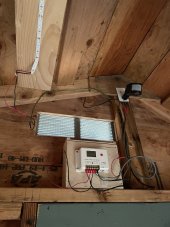PLShutterbug
New Member
- Joined
- Dec 31, 2022
- Messages
- 2
First time poster here, thanks for the forum. I'll check back for responses.
Need advice on creating a heating solution for occasional below-freezing weather for my shed lighting system. Basically, what is the right size for my use case.
Background:
I have a small backyard shed, unheated (not necessary), where I've set up a single 3 meter strip of LEDs to a 10 watt solar panel, 10 amp solar charge controller, motion detector, and Lossigy 8AH 12v LiFePO4 battery (no link available) that is 60mm wide x 400mm long x 300mm tall. The solar panel is on the north side of the shed, and the battery case is high up (about 2.5 meters above the floor) against the north wall of the shed as well. When I built the shed I didn't want the solar panel highly visible and was concerned about thermal gain in summer harming the battery, hence my decision to mount at the north rather than the south.
I want light in the shed so I can see. I go in there for maybe 5 minutes at a time a few times per month. On really busy days I may go in and out of the shed 6 times, again for less than 5 minutes each. Take out the lawn mower; mow the lawn then put it back. Search for wood for a project; etc. I didn't want to hook up to house mains power so hooked up the solar-based kit above last spring. I don't want to forget to turn off the light and drain the battery, so set up the motion detector and it keeps the lights on for about 5 minutes before automatically shutting them off. To date this has worked exactly as planned.
I also have a 50 watt solar panel I have never hooked up because the 10 watt powered the LEDs just fine. I could swap out the 10 watt panel for this one pretty easily. It may factor in the discussion.
Problem:
I live near Seattle and a few days per winter the temperature drops below freezing. Last week it dropped to -7° C for 4 straight days. Then we had several days of heavy rain so little chance for the solar panel to recharge the battery. Now it's about 4° C again. Yesterday when I went to the shed the lights did not come on when I opened the door, and my charge controller showed E01 (battery low voltage state). I hit the controller's reset switch and the lights came on again. This morning when I went out to take pictures for this post the lights did not come on, and the controller's screen is blank.
I've verified that my charge controller does not have a low-temperature charge cut-off. So I may have destroyed my LiFePO4 battery by leaving it out there in the cold with a charger that attempted to charge it while below freezing.
Proposed solution:
I'll buy a new battery if I need to ... no problem. However, I don't want to go through this again so I'm thinking of two possible improvements to my system:
I see several 12v 10a thermostat control switches available for very little money. At 120 watts these seem to have enough overhead to accommodate either of my solar panels.
Here is my proposed solution. Is it reasonable?
Need advice on creating a heating solution for occasional below-freezing weather for my shed lighting system. Basically, what is the right size for my use case.
Background:
I have a small backyard shed, unheated (not necessary), where I've set up a single 3 meter strip of LEDs to a 10 watt solar panel, 10 amp solar charge controller, motion detector, and Lossigy 8AH 12v LiFePO4 battery (no link available) that is 60mm wide x 400mm long x 300mm tall. The solar panel is on the north side of the shed, and the battery case is high up (about 2.5 meters above the floor) against the north wall of the shed as well. When I built the shed I didn't want the solar panel highly visible and was concerned about thermal gain in summer harming the battery, hence my decision to mount at the north rather than the south.
I want light in the shed so I can see. I go in there for maybe 5 minutes at a time a few times per month. On really busy days I may go in and out of the shed 6 times, again for less than 5 minutes each. Take out the lawn mower; mow the lawn then put it back. Search for wood for a project; etc. I didn't want to hook up to house mains power so hooked up the solar-based kit above last spring. I don't want to forget to turn off the light and drain the battery, so set up the motion detector and it keeps the lights on for about 5 minutes before automatically shutting them off. To date this has worked exactly as planned.
I also have a 50 watt solar panel I have never hooked up because the 10 watt powered the LEDs just fine. I could swap out the 10 watt panel for this one pretty easily. It may factor in the discussion.
Problem:
I live near Seattle and a few days per winter the temperature drops below freezing. Last week it dropped to -7° C for 4 straight days. Then we had several days of heavy rain so little chance for the solar panel to recharge the battery. Now it's about 4° C again. Yesterday when I went to the shed the lights did not come on when I opened the door, and my charge controller showed E01 (battery low voltage state). I hit the controller's reset switch and the lights came on again. This morning when I went out to take pictures for this post the lights did not come on, and the controller's screen is blank.
I've verified that my charge controller does not have a low-temperature charge cut-off. So I may have destroyed my LiFePO4 battery by leaving it out there in the cold with a charger that attempted to charge it while below freezing.
Proposed solution:
I'll buy a new battery if I need to ... no problem. However, I don't want to go through this again so I'm thinking of two possible improvements to my system:
- Install a thermostat-controlled switch that shuts off charging at below freezing, or replace my controller with one with this already there. Probably the simplest and least expensive solution, but it means I give up light in my shed during below-freezing weather. I don't prefer this.
- Install a thermostat-controlled heating system and upgrade the box to add insulation, so the battery can charge during cold snaps but still be protected against below-freezing weather. I prefer this.
I see several 12v 10a thermostat control switches available for very little money. At 120 watts these seem to have enough overhead to accommodate either of my solar panels.
Here is my proposed solution. Is it reasonable?
- Keep the existing charge controller
- Keep the 8AH 12v battery if possible; buy a new one if the old one is toast
- Build a better-insulated box to house the heater, battery, and controllers
- Electrically, hook the thermostat directly to the battery so the heater draws power from it
- Maybe swap the 10 watt panel for the 50 watt panel
- How to cut off charging from the solar charger if the temp is below freezing and the battery is fully discharged?
- Alternately, how big a battery do I need to ensure all-night heating with 16 hours of darkness in the winter, without having to worry about #1?
- Will I need to switch to the 50 watt panel to ensure sufficient power during short winter days to charge the battery?






